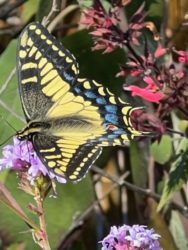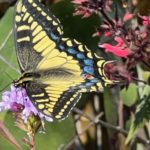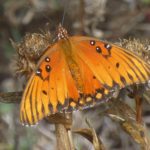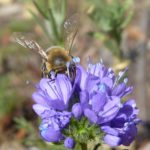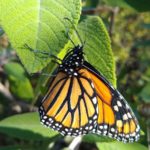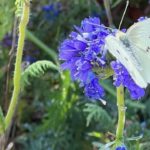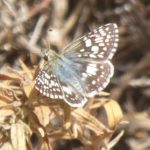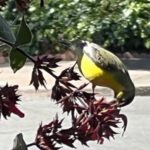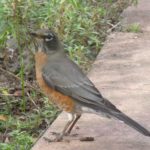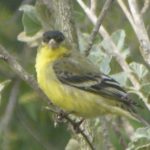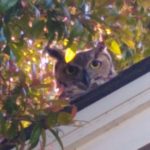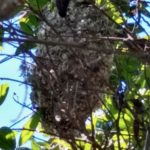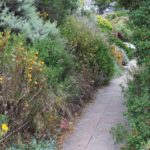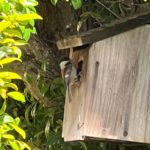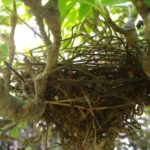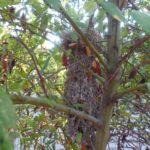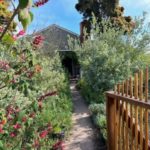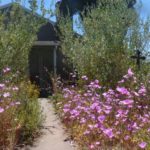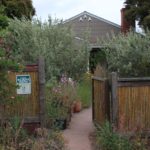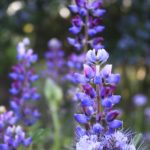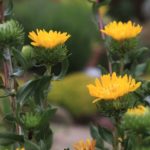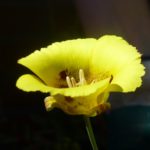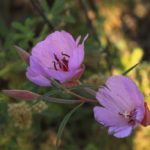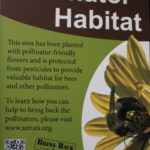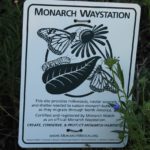Lot size: 3,000 sq. ft. front garden, front slope, and parking strip, 90% native
Garden Age: Garden was installed in stages, beginning in 2007
Years on the Bringing Back the Natives Garden Tour: 5
Showcase Feature
Anita’s passion is the conservation of species, both plants and animals. She takes her cues from nature, and gardens “on the wild side”. Her garden, which contains more than one hundred species of native plants, is dense, to create nesting sites for birds and other wildlife. In the springtime nesting season the garden is bustling with extra activity—from scrub jays collecting dead twigs to bushtits collecting spiderwebs with which to build their “sock” nests.
The garden is also lush, unmulched, and unraked—just the way critters and birds need. Bushtits, scrub jays, and chestnut-backed chickadees nest in the garden regularly. Anita has counted nest twenty six nests in her garden in just the last five years. Hummingbirds, towhees, Bewick’s wrens, bushtits, goldfinches, mourning doves, and titmice are constant guests, and can be seen in the garden daily, feeding on caterpillars, other insects, and the seeds that the native plants provide in great abundance.
Acmon blue, anise swallowtail, and monarch butterflies flutter from flower to flower, feasting on nectar from the wide variety of colorful native flowers in this garden. Numerous native bee species, including bumble, carpenter, sweat, and leafcutters, collect pollen and sip nectar, while pollinating flowers. Slender salamanders sleep undisturbed under unraked fallen leaves. Timid (and harmless) gopher snakes come to visit. Anita beams, “It’s like living in Paradise!”
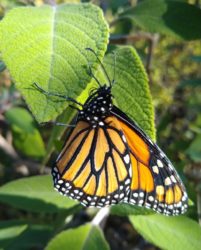
Other Garden Attractions
• The steep slope was once totally covered with decades-old ivy, which was removed by hand.
• Only new plants and seedlings are watered; this conscientious couple used less than 40 gallons of water a day last summer.
• As they are gardening for wildlife, no pesticides are used in this—or any—Tour garden.
• There is a real sense of community among Anita and her fellow native plant gardening neighbors—Dave, and Margot. They and their partners have barbecues, wine-and-cheese soirees, and ping-pong parties. They share seeds, plants, advice, and freely assist other neighbors interested in gardening with natives.
• Stroll directly across the street to see another neighbor’s formerly ivy-covered parking strip, which Anita and Dave, with permission, converted into a habitat/pollinator garden with native wildflowers and perennials.
Gardening for Wildlife
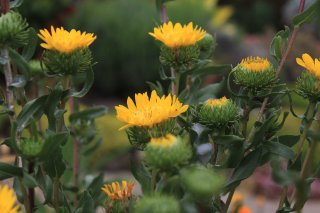
To provide food for birds, plants are allowed to go to seed, berries to ripen, and insects to thrive in the garden. The birdbath and small pond provide much-needed water. Rock piles radiate warmth for salamanders, and lizards. Unmulched soil provides nesting areas for native bees. Fallen leaves remain undisturbed to protect slender salamanders, pupating butterflies, and other insects.
These plants are required by checkerspot, field crescent, Mormon metalmark, bramble hairstreak, lupine blue, the Gorgon copper (and many moreI) butterflies in order for them to reproduce. In turn, thousands of the caterpillars the butterflies and moths create are required by baby birds while they are in the nest. Baby birds don’t eat berries, or seeds, or sugar water—they must have caterpillars.
Keystone species (watch this talk by Doug Tallamy!)
Keystone species—our own, local ecological powerhouse plants—in this garden include California lilac, wild rose, manzanita, lupine, goldenrod, sage, aster, snowberry, buckwheat, woodland strawberry, and penstemon.
Parking
Park near the intersection of Burlingame, Merced, and Santa Clara.
Talks in the Garden
11:00 “How to turn your garden into a wildlife paradise” by Anita Pereira
2:00 “How to turn your garden into a wildlife paradise” by Carol Thornton


